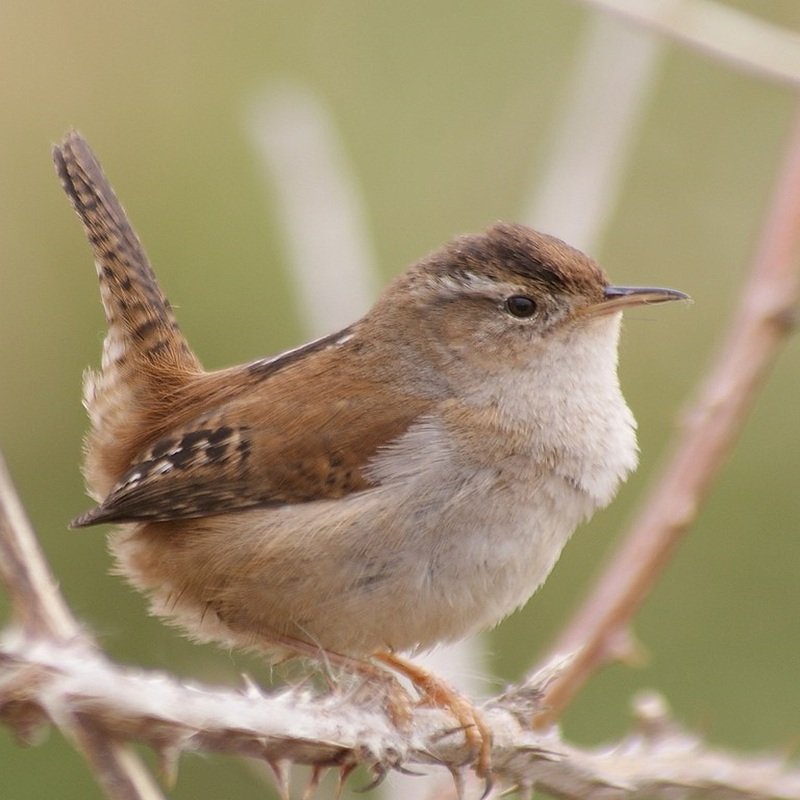Known as the Marsh wren, Cistothorus palustris is a small songbird belonging to the wren family that lives in North America. They are members of the Troglodytidae family. The sedge wren, also known as the short-billed marsh wren, is sometimes referred to as the long-billed marsh wren.
This wren’s diet consists solely of insects that it collects from plants as well as the water’s surface. Because it is such a secretive bird, even the singing territorial male keeps his location a secret by briefly climbing a cattail to get an unwelcome look at an intruder.
Quick Overview: Cistothorus Palustris – Marsh Wren
Body size: Around 4.5-5 in (11-13 cm) and a weight of 11 g (0.4 oz)
Main colors: White, Brown, Black,
Range: Throughout the United States
Migratory Bird: Yes
Best time of the year to see in the U.S.: All Year (January- December)
Conservation Status: Least Concern
Marsh wren Description
The Marsh Wren is a small wren, weighing between 9.0 and 14.0 grams. Both sexes have similar plumage. White superciliary stripes, warm-brown upperparts with faint black bars, buffy sides, and breast, whitish below, dark barring on the tail. Their bill is brown and they have brown eyes. Men are bigger than women, though body size varies by region.

Size
These birds have a length of 4.5-5 in (11-13 cm) and a weight of 11 g (0.4 oz). Their wings could range 5-5.7 in (14-18cm).
Feeding
Mosquitoes, spiders, and aquatic invertebrates are all eaten by Marsh Wrens. Marsh Wrens forage on or near the marsh floor, catching insects from vegetation and the water’s surface.
Habitat
Marsh Wrens inhabit a range of wetlands. Most Marsh Wren habitat is dominated by cattails and bulbrush. This wren inhabits salt and brackish marshes as well as freshwater. Winter range habitat is similar to breeding range habitat.
Behavior
Males defend 60-10,000 m2 during the breeding season. Territory size is probably inversely related to male quality and positively related to male territory quality. Territorial quality predicts resident male reproductive success. Females defend their sub-territories fiercely against intruders. The males chase each other through disputed areas of the territory and sing energetically during the encounter.
Cistothorus Palustris Scientific Classification
- Kingdom: Animalia
- Phylum: Chordata
- Subphylum: Chelicerata
- Class: Aves
- Order: Passeriformes
- Family: Troglodytidae
- Genus: Cistothorus
- Species: Cistothorus palustris
Best time of the year to see
In the United States, the best time of year to see these birds is all year round, regardless of the season. This refers to any month of the year between January and December.
Distribution of the Marsh wren in the USA
The Marsh wren breeds from the Atlantic coast to Nebraska and from southern Illinois to northern Illinois. Their species is a year-round resident in the west. Breeding and resident populations exist along the southern Atlantic and Gulf coasts. During winter in Florida as well as the southwestern states of New Mexico, Arizona, and Texas.
The Marsh wren can also be found in the following states in the United States – Alabama, Alaska, Arkansas, California, Colorado, Connecticut, Delaware, Georgia, Hawaii, Idaho, Indiana, Iowa, Kansas, Kentucky, Louisiana, Maine, Maryland, Massachusetts, Michigan, Minnesota, Mississippi, Missouri, Montana, Nevada, New Hampshire, New Jersey, New York, North Carolina, North Dakota, Ohio, Oklahoma, Oregon, Pennsylvania, Rhode Island, South Carolina, South Dakota, Tennessee, Utah, Vermont, Virginia, Washington, West Virginia, Wisconsin, and Wyoming.

